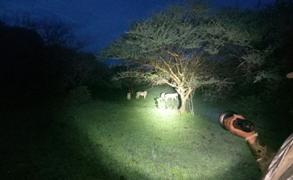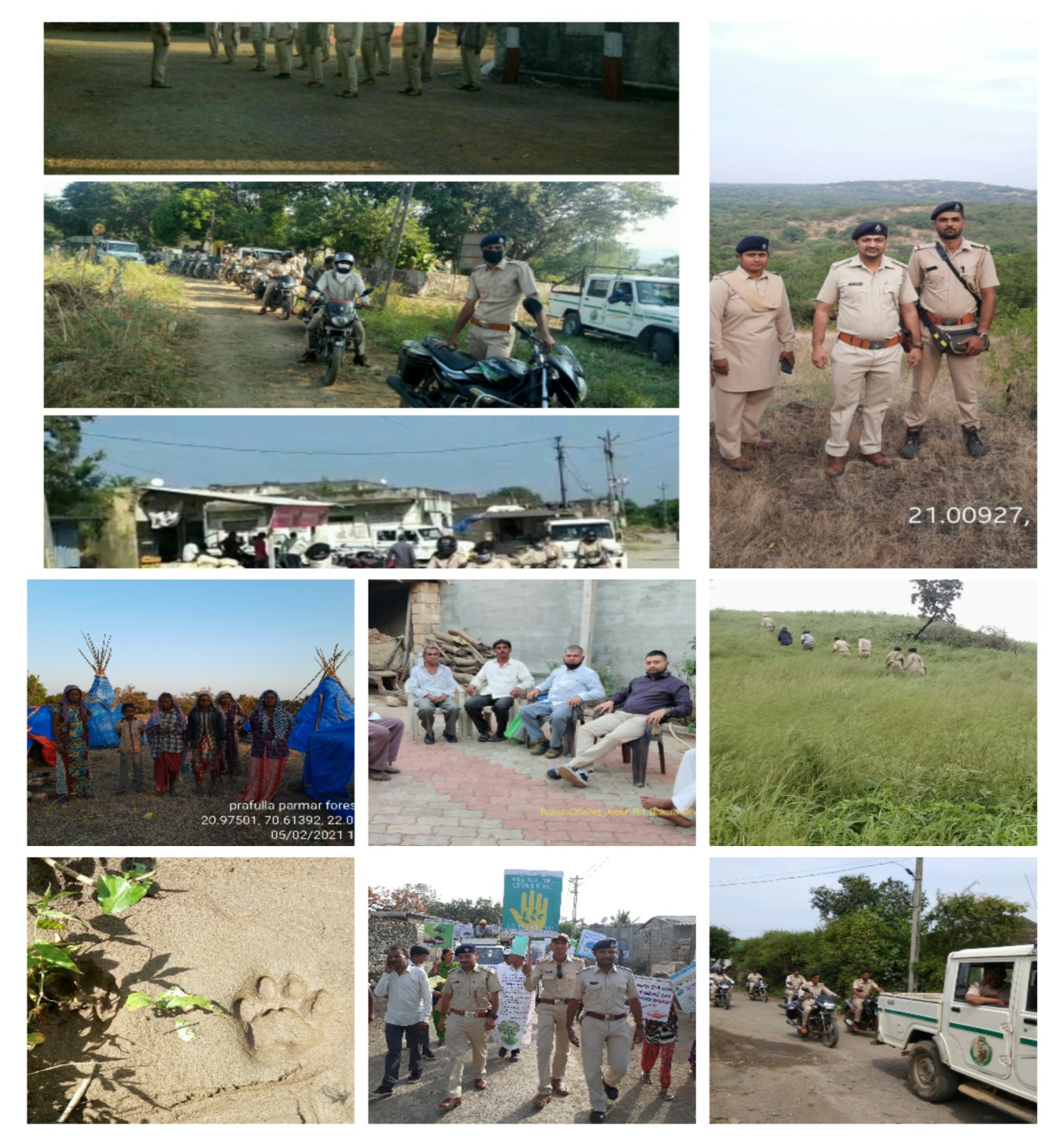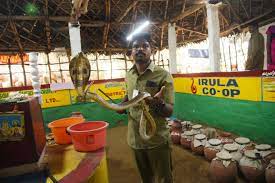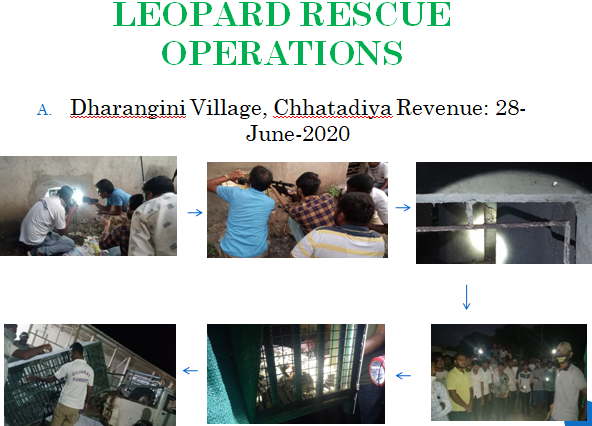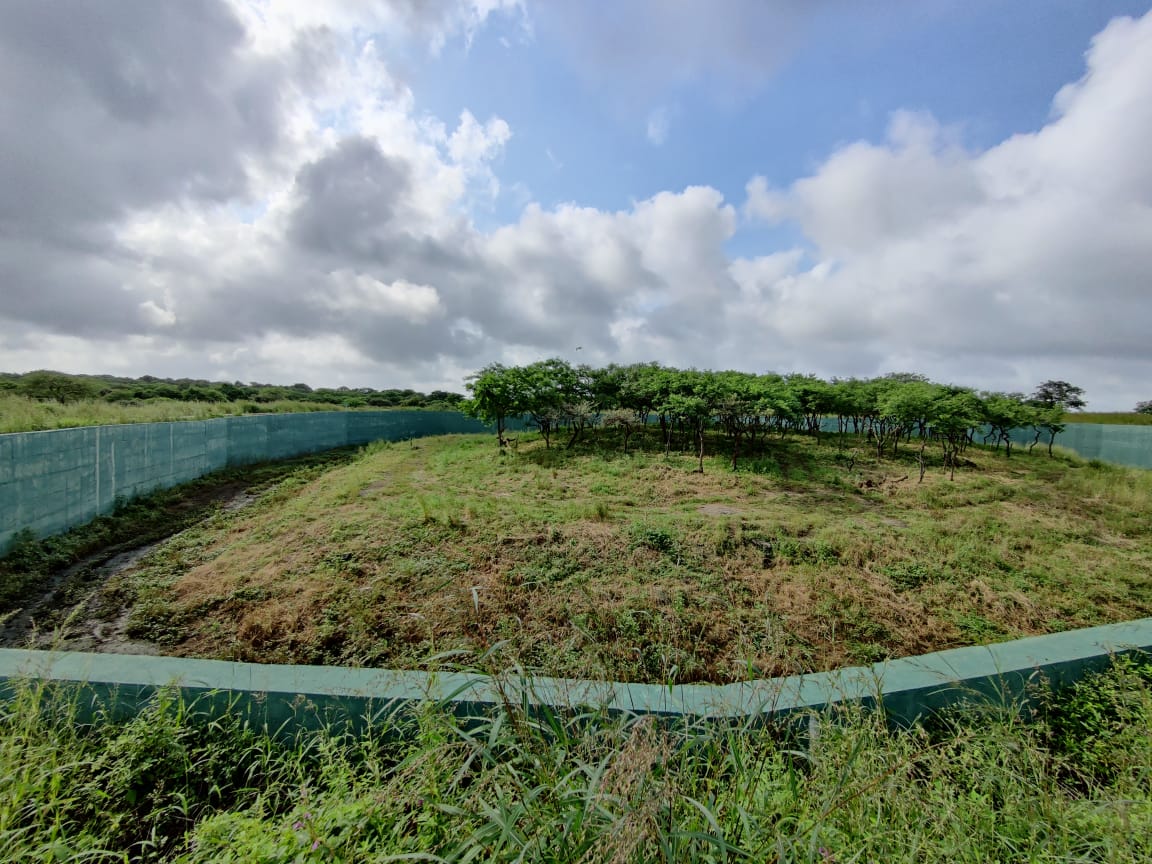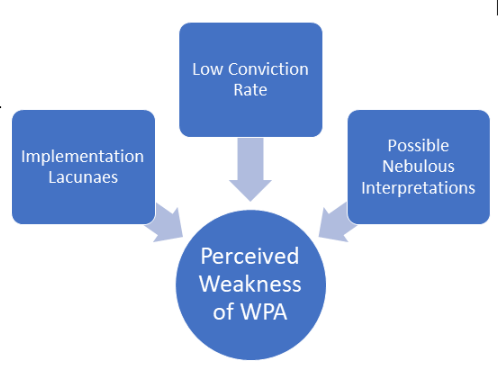50 Years of WPA - A Critical Analysis Part-1
Blogs Home
- 07 Jun 2023
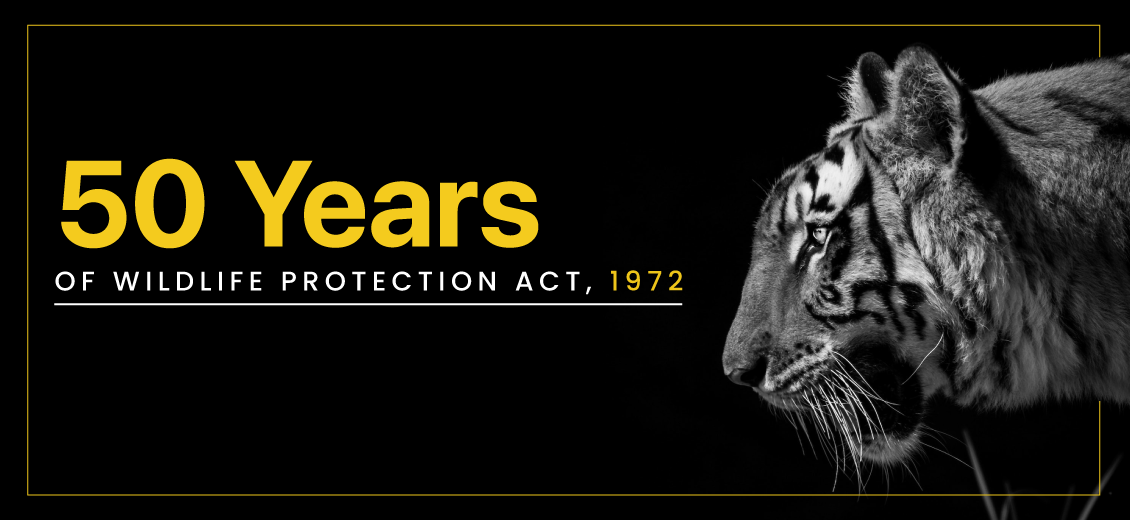
About the Author

Ayush Verma, an Indian Forest Service Officer of 2018 batch, Gujarat Cadre, is a recipient of Government of India's Gold Medal in All-Round Outstanding Performance, Gold Medal for Topper in Core Forestry and Sanjay Singh Memorial Prize along with Hill Memorial Prize, K.M. Tiwari Memorial Prize for Forest and People, Dr. B.N. Ganguly Award of Academic Excellence and K.P. Sagreya Shrestha Vanik Puraskar in his professional training at IGNFA.
An Engineering Graduate from IIT BHU, he presented a model on Geo-Sequestration in Tata Steel that evinced his interest in the field of environment. His natural love for outdoors, compassion for animals and an internal urge to pay his "Prakriti Rna" to Mother Nature has drawn him into Forest Services.
He has authored a Book on Patrolling Plan for GIR during his stint as Assistant Conservator of Forest in Gir (West) Division. Currently he is posted as Deputy Conservator of Forests, Social Forestry Division Botad with jurisdiction over Botad and Bhavnagar – both of which are part of Greater Gir region.
In the Forestry Sector, his areas of interests include Forests and People (for which he had Written a Report on "Tribals and Forests" in his IGNFA stint) and Wildlife Conservation to which he dedicates his self-authored PATROLLING PLAN FOR GIR. For this seminal work he has been awarded with SKOCH AWARD for Governance too.
In this write-up, he encapsulates his opinion on the Wildlife Protection Act, 1972 by an attempt to present a slice of his field experiences and ground knowledge as a forester. He attempts to point out the different practical and procedural aspects in implantation of WPA. To make his inferences and his personal opinion more objective, he has drawn a SWOT Analysis of this Act.
DISCLAIMER
The Views expressed here are purely in personal capacity and not in official position. The author tries to present a dispassionate analysis of the Wildlife Protection Act based on his field experiences, learning of professional training and his observations as a forester. In no manner or way, should this write-up be interpreted as views of the government, whether wholly or partially.
Scheme of this Blog
The Blog will be published in two parts-
Part I:
- WPA in the Backdrop of Wildlife Protection
- Strengths and Positives of WPA
- Perceived Weaknesses and Scope for Improvement
Part II:
- New Opportunities to bolster Wildlife Protection Framework
- Perceived Threats to Wildlife Protection Framework
- Author’s Take on the 50 Years of WPA
This is Part I of the Blog for Part II Click here.
WPA in the Backdrop of Wildlife Protection
William Temple Hornaday in his seminal work ‘Our Vanishing Wildlife’ (1913) first coined the word “Wildlife” to connote the Species other than the so dubbed ‘Civilised’ Man. He emphasized on their right to Co-Habitat the Mother Earth. This book was authored in the backdrop of their extermination owing to unbridled hunting – for the world had witnessed plummeting count of a species galore! For Instance, Passenger Pigeon in the beginning of 19th Century were known to travel in such huge flocks that they literally darkened the sky where they used to fly. Just over a century later- a nano-miniscule time period in Earth’s evolutionary history, the world witnessed the last Passenger Pigeon in 1914!!
This contextualises the need and essence of wildlife protection and to impose a veritable moratorium on equating hunting as a ruthless ‘Sport’ that banks on the false show of Valour involved in it. Inter alias, Wildlife Conservation History of India, maybe traced to major legislations like Wild Birds Protection Act, 1887 or Wild Birds and Animals Protection Act 1912 etc. during the British era. But the General Spirit of all these laws was to maintain the Wildlife Population for Sustainable ‘Game Reserves’ of the royals – the British and the Princely States alike…
Post-Independence India may have floated laws like Prevention of Cruelty to Animals Act, 1960 but it is certainly the Wildlife Protection Act, 1972 or the WPA that laid the real solid Edifice for a legal framework for Wildlife Protection in India. WPA, 1972 that enabled India then to become a party to CITES had following Notable Objectives:
- Prohibition and/or Regulation of Hunting
- Protection and Management of Wildlife Habitats
- Establishment of Protected Areas
- Regulation and Control of Trade in Wildlife
Presently, when the celebrated WPA, 1972 has completed its 50 Years and in that Journey it has seen some major amendments like in 1991, in 2006 and recently in 2022 and its supplementation with a number of rules and guidelines, I feel it is germane to analyse the different aspects and dimensions of this Act with reference to its utility and applicability on the field in capacity of a serving forest officer, its procedural aspects that impacts its implementation in the legal realm, its readiness to cope up with the dynamics of wildlife crime, its impact on the ground to deter the wrongdoers, its strengths and shortcomings, the practical aspects in its implementation, blah blah… and to cut the long story short a SWOT ANALYSIS of the WPA - based on my field experience, learning of my professional course and on-the-job and in-service training pertaining to the Wildlife Offences.
Strengths and Positives of WPA
WPA is a landmark act in Conservation and Protection of the Wildlife of the country. Its strengths could be gazed from following aspects:
A. Provided Solid Legal Framework to Systematically Check and Prevent Wildlife Offences and in event of commission or an attempt of the same take penal action.
Examples:
- Section 9 of WPA Explicitly prohibits Hunting and Hunting has a very wide interpretation as defined by Sec. 2(16) as: hunting" includes
(a) Capturing, killing, poisoning, snaring, or trapping any wild animal, and every attempt to do so.
(b) Driving any wild animal for any of the purposes specified in sub clause.
(c) Injuring, destroying or taking any body part of any such animal, or in the case of wild birds or reptiles, disturbing or damaging the eggs or nests of such birds or reptiles.
Field Experience
Photo from GIR East Division – an attempt of Lion Show that was foiled by forest staff
With such an elaborate definition of Hunting, it really becomes a big deterrent for the public and the wrongdoers to engage in activities of intentional teasing or luring the animal. As Assistant Conservator of Forest in GIR Forest, this section and definition was invoked by me and my field staff to check the Illegal Lion Shows – Baiting the Lion to bring him to a point for public display primarily for pecuniary interest.
- Declaration of Protected Areas as Wildlife Sanctuaries under Sec. 18 and of National Park under Sec.35 and Detailed Provisions of Prohibited actions under Chapter 3 of WPA
Field Experience
Forest Khaki in Action- THE GREEN POLICE (GIR West Division)
Trespassing and entry into Sanctuary area, ban on use of injurious substances, causing fire and destruction: part of routine patrolling and vigilance maintained from watchtower and other patrolling infrastructure, forest staff
Notably, in Tribals and er Forest dependent communities, often a tendency to cause fire intentionally is observed – Pastoralists for fresh flush of grass and Honey-Collector Tribals like Kattunayakans (South India) are notorious for the same. To counter it Sec. 30 of WPA: Causing fire Prohibited is invoked by the forest department.
- Punitive Action against the Wrongdoers: Chapter VI and VI A of WPA deals exclusively with dealing of offences against Wildlife.
Sec. 50(8) in particular equips the forest officers not below the rank of Assistant Conservator of Forest to Issue Search warrant; enforce attendance of witness and record evidences.
It is noteworthy that confessions made before forest officers are admissible in courts as evidences – case of Aboobacker vs. State of Kerala (1989).
Field Experience
Owing to Higher Penalties and Stringent Punitive actions under WPA, on field WPA provisions are often invoked even while applying the case of Indian Forest Act, 1927- to make our case against the wrongdoer stronger. Sec 56 of WPA states operations of other laws not barred while applying WPA. Likewise to make our case stronger we club WPA with sections of CrPC, IPC and Arms Act etc.
Sec 52 of WPA – exclusively deals with attempts and abetments. On field, this helps to check malefic actions as attempt to hunt. For instance, in February, 2022 a group of casual workers were caught with snare traps in Gir Somnath District, Gujarat. They were nabbed on attempt to hunt.
Likewise, abetments or assistance in wildlife offence forms the basis to unearth deep nexus of Wildlife Crimes as Organised Crimes.
- Non-Bailable and Cognizable Offences in case of Schedule 1 Species and case of Repeated Offender. Also, term of Punishment in such cases is minimum 3 years. Notably Forfeiture of Property derived from Illegal Hunting and Trade is too explicitly provided for under WPA
Field Experience
Law Courts have in general taken a pro-wildlife stance provided we are able to reasonably prove our case. Here too, Sec 57 of WPA explicitly shifts burden of proof on the accused if they are found to be in possession of animal article.
It fills me with delight to mention that in stint as Assistant Conservator of Forest, GIR WEST- of the four different Wildlife offence cases in which I was the Investigating Officer, in all four cases bail was rejected by the lower court and one case of illegal lion show even went to Hon’ble High court and here too bail was rejected by Hon’ble Court.
Power to Compound Offences under Sec 54 and to cancel license under the Arms Act 1959 of the person convicted in Wildlife offence: These are some commonly deployed deterrents on field against the wrongdoers.
Sec 34A of WPA Explicitly Empowers the Forest officers of Rank ACF and above to remove Encroachment. With immense satisfaction I share that I have invoked this Section multiple times to remove e ncroachment from the Gir Sanctuary Area
 |
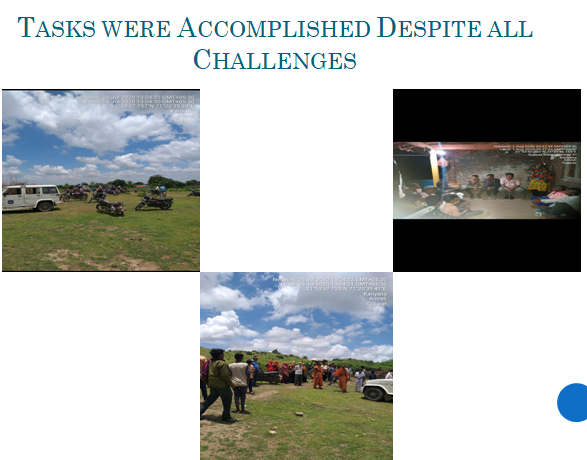 |
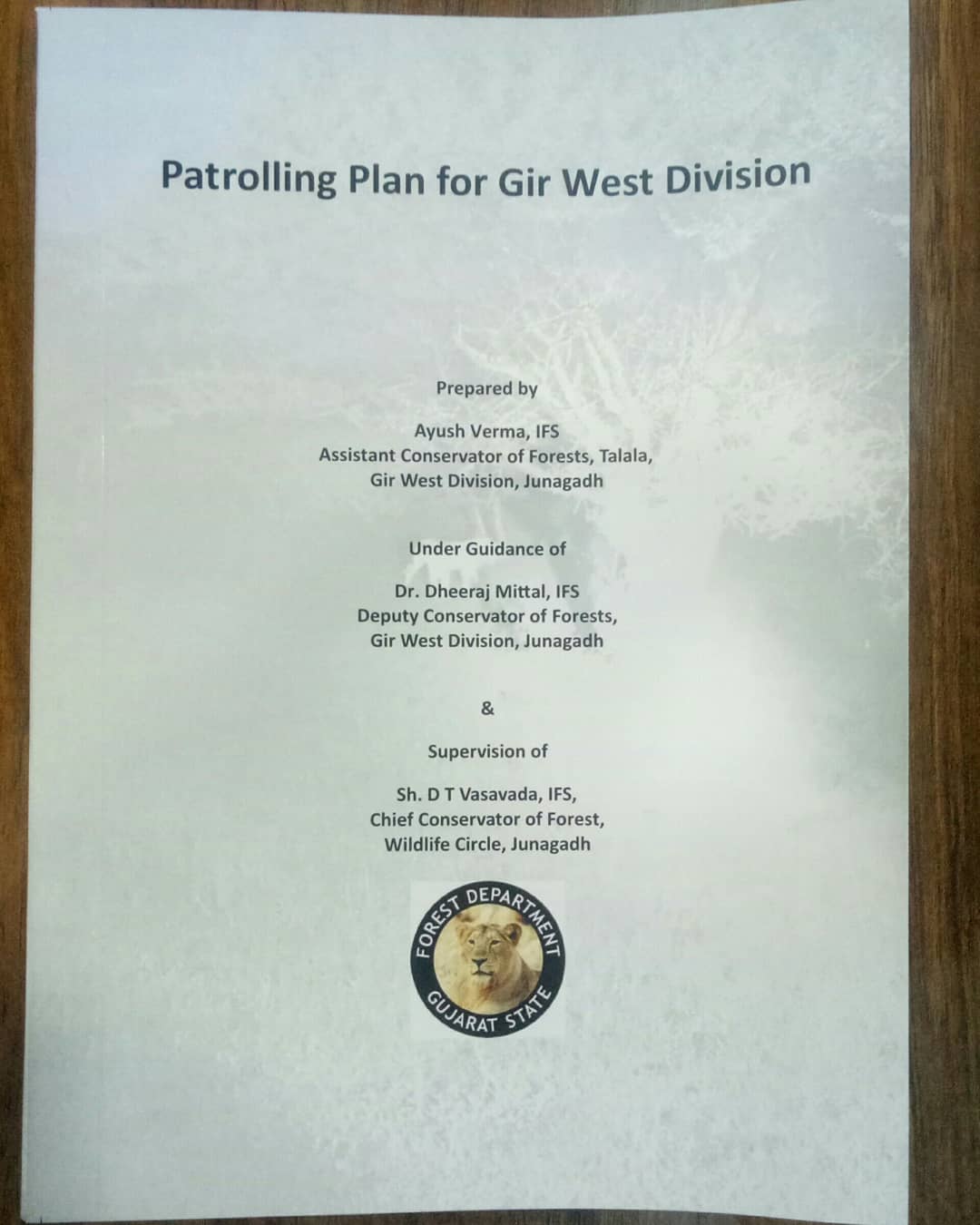 |
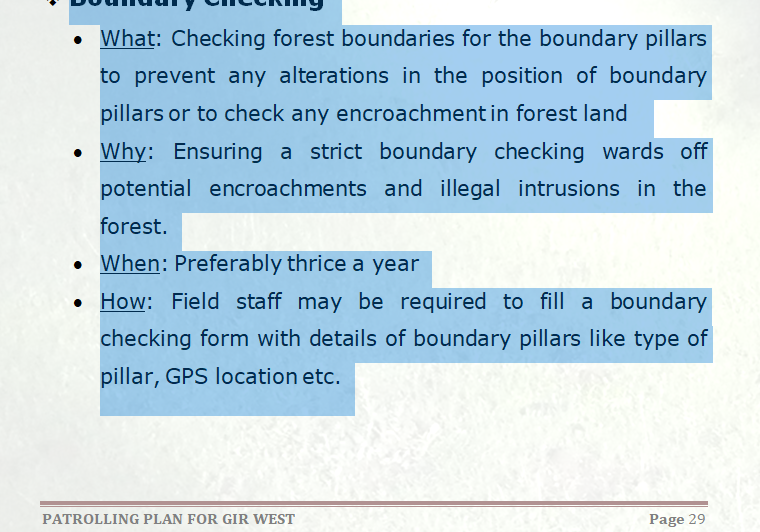 |
Boundary Pillar Checking Exercise is also a routine measure that is carried out by the Gir West Staff. This is meant to ensure that no damage is done to the Boundary Pillars that demarcate the Wildlife Sanctuary from Adjoining Areas. I am pleased to inform that in my book ”Patrolling Plan for Gir West Division”, inter alias, in the Blueprint for Patrolling activities I have also mentioned Boundary Pillar Checking Exercise
Hence, to infer I wish to point out that WPA has provided a concrete legal framework both to Prevent and Punish the Wildlife Crimes
B. Zoo Management
Its Popular to realise and recognise that Zoos are Biological Spaces for the Wild – hence, wildlife-friendly enclosures is the new norm for Zoos today
Thanks to WPA and its evolution through 1991 Amendment that established the Central Zoo Authority (CZA), Zoos are no longer a typical menagerie: collection of wild animals earlier meant for recreational purposes, rather they are now seen as Biological Parks – and rightly so
Constitution of CZA under Chap IV A of WPA clubbed with the National Zoo Policy, 1998, Central Government’s Orders prohibiting the sale of animals by Zoo and The Recognition of Zoo Rules, 2009 has greatly standardised the zoo operations in terms of animal spaces, their health and their transfers.
Field Experience
- Post WPA and establishment of CZA, there are specific rules and scientifically-sound guidelines on Transfer and Exchange of Wildlife. CZA Norms and Sec. 38 I on Acquisition of animals by Zoo are being Strictly adhered to any such wildlife movement.
- Sec 38H, WPA provides for strict norms on Recognition of Zoos that are adhered to.
- Further, Classification of Zoos based on Defined Norms is done into Mini, small, medium and Big Zoo.
- Zoos have also become extension and entry-point for forest department in view of the Edutainment: Entertainment clubbed with Education to masses – thanks to CZA’s progressive Norms and WPA’s legislative backing.
- Maintenance of Stud-books by Zoos on Endangered Wildlife is a welcome step as it Monitors Individuals.
C. WPA provides for Scientific Management of the Wildlife under Sec 12(bb) that includes translocation of wild animals to alternative suitable habitat and Population Management of Wildlife. It also permits derivation, collection or preparation of snake-venom.
Field Experience
1. In view of increasing count of lions, its territorial nature and its behaviour to prefer scrub and open forest, it is common for this mega-fauna to venture into human habitation is a cause of increasing human-wildlife conflict. In view of the same, inter alias, it is planned to house a satellite population of lions through translocation to Barda Wildlife Sanctuary, Porbandar.
2. In Chennai, Tamil Nadu Forest Department actively ropes in the Irula Snake Catchers (traditional snake-charmers) for preparation of Anti-Venom Drugs.
3. Captive Breeding of Endangered Species at Zoos has played a vital succour in getting such species extinct. Sakkarbaug Zoo, Junagadh for instance carried out successful captive breeding of Vultures, Gray Wolf, Asiatic lion and even Chital-Sambar for replenishing prey base for lions and thus check human-wildlife conflict.
D. Conservation Success Stories
Flagship Wildlife Conservation Projects post enactment of WPA has helped check their dwindling counts. The same got supported by National Wildlife Action Plan 1983 and such subsequent plans. Also, Flagship Government Programmes like Integrated Wildlife Development Programme – It was Provisions of WPA that helped in achieving these goals, whether fully or partially. Also, specific Provision of National Tiger Conservation Authority (NTCA) under Chapter IV B of WPA post amendment in 2006 has, through focus on Tiger, helped conserve the entire ecosystem of the forest.
Some Notable Conservation Success stories are as under:
- Project Tiger 1972
- India Rhino Vision 2020
- Project Elephant 1992
- Project Hangul 1970
- Project Lion 1972, re-launched in 2020
- Project Crocodile 1975 …to mention just a few!
Field Experience
There is a Scientific Basis of Conservation of Such Flagship Species i.e., these Species are very often the UMBRELLA SPECIES which means a species whose conservation is expected to confer protection to a large number of naturally co-occurring species – protection rendered to them would help conserve all species in that food web.
For Instance, it is no co-incidence that population count of herbivores in Gir Wildlife sanctuary has commensurately raised with the count of Asiatic Lion.
E. Counter the Wildlife Crimes and Illegal Wildlife Trade
Chapter IV C of WPA constitutes WCCB or the Wildlife Crime Control Bureau that is Inter-Disciplinary in approach as it assists collaboration Forest, Police and Customs Officials.
Chapter V of WPA tightly regulates Trade and Commerce in Wild Animals, Trophies and Animal Articles while Chapter VI A explicitly calls for Forfeiture of Property Derived from illegal trade or Hunting.
Field Experience
WCCB has conducted a number of Operations to tackle Wildlife Crimes. Some Noteworthy initiatives are:
- Operation Thunderbird – With Collaboration of Interpol
- Operation LESKNOW – Protection of Lesser Known Species
- Operation Save Kurma – Turtle Conservation
- Operation Freefly – Save Birds
- Operation Wildnet – To check Cyber-Poaching
In actualising all these operations, WCCB has to maintain a close-liaisoning with forest officials. Manpower and other Resources are of the Field Division. WCCB helps gather Intelligence and guides in Procedural Aspects.
WCCB has also started Training IFS Officials in Wildlife Crime Prevention and Detection
To deal with illegal Possession of animal Articles, on Field, apart from the WPA Provisions mentioned above, Wildlife Stock Declaration Rules, 1973; Wildlife transactions and taxidermy rules 1973; Wildlife licensing rules 1983 and Declaration of WL Stock Rules 2003 come handy.
F. Dealing with Human-Wildlife Conflicts
Due to rising Human Population and materialistically oriented lifestyles of today, Anthropogenic Pressure on Forest and thus the very existence of Wildlife is at Cross-roads, but WPA does provides for dealing with these issues, as:
- Section 11 allows for Hunting in grave case of it becoming dangerous to human life or is diseased beyond recovery provided that the Chief Wildlife Warden of the State is satisfied that it can’t be captured, translocated or tranquilised OR the Wildlife is Diseased or Disabled beyond Recovery.
- Also, Killing an Animal in Self-Defence won’t be an offence: upheld by Hon’ble Court in Tilak Bahadur Case (1979) as well.
- Declaration of a Species as VERMIN- Sec 62 of WPA: Allows Culling of Specific Species (not Schedule 1) for a Specific Period for a Specific Area.
Field Experience
1. In Gir and Greater Gir Area, Tranquilising a Leopard that seems to have become dangerous or routinely ventures into human habitation is the norm. In case, if it is found to be involved in human injury or death – ascertained through Scat Analysis, it is not released back into the wild for it could become dangerous.
Glimpse of a Leopard Rescue Operation Carried out by GIR East Field Staff
2. As Leopard-Human Conflict is on the Rise, for POPULATION MANAGEMENT At GIR-SASAN, concept of Gender-based Segregation of Leopards is being followed in which male leopards are kept in kraals while females are kept in an Open Moat – that mimics natural forest. This checks breeding and further offspring propagation is curbed without resorting to cruelty!
Pic from Sasan-Gir displaying Open Moat Enclosure for Housing Leopards
3. In Himachal Pradesh, owing to big menace of the Rhesus Macaque, their Sterilisation has been allowed on Temporary basis
4. Declaration of Some Species like Wild Boar and Blue Bull as VERMIN have been done in several states: Much owing to their Crop depredation tendencies
G. Rights of Forest Dwellers, Scheduled Tribes and Responsiveness to Communities
WPA does factors in the Critical Role of Communities in Wildlife Conservation. This could be gazed from its provisions as under:
- Community Reserves (Sec 36A of WPA) and Conservation Reserves (Sec 36C of WPA): Both envisage role of Communities in Preservation and Protection of Wildlife. In former, the land is owned by the Community while in latter land is owned by government but managed jointly with communities for conservation of wildlife.
- Settlement of rights of the affected community is done under Sec. 19 to 24 of WPA before declaration of a Wildlife Sanctuary. In case of National Park, it is mandatorily done prior to its declaration.
- WPA in Concurrence with the Forest Rights Act, 2006 provides for relief and rehabilitation before relocation to a new place – as per Sec 38V(4) and (5) deals at length about Obtaining Informed Consent of Gram Sabha and Alternate Livelihood. Its Spirit however is man-wildlife co-existence as far as possible – i.e. no relocation especially in Non-Core Area of Tiger Reserve.
- Sec 65 of WPA Explicitly Preserves Hunting rights of tribals of Nicobar Islands in view of their traditional culture that they couldn’t be possibly weaned from.
- Sec 4(bb) provides for an Honorary Wildlife Warden – a community leader who will uphold the cause of Wildlife Conservation and help the forest department liaison better with communities.
Field Experience
As per Kinshasa Model of Conservation, Community-owned Wildlife Conservation is the key for sustaining wildlife-human co-habitation and abating human-wildlife conflict.
1. Maldharis (Pastoralists) of Gir are known to have a Peaceful Co-Existence with the lions and I have Witnessed the Same – there is a reverence for the Lion in their culture. Ness is an Area in Gir that is inhabited by Maldharis. Post 1972 after Joslin’s Study in Gir Forest, they were relocated outside GIR but due to absence of good fertile agriculturally suitable land or grass sustaining land, no relocation was done since 1998. There are around 43 Ness in Gir Forest as of records 
2. In Gir as well as Greater Gir Area, there is a Concept of SINH MITRA – people from Community as roped in to serve as agents of liaisoning and Sensitisation of the Communities. They are also Actively Roped in Lion Rescue Operations –that requires a considerable Community support to be Successful.
3. Deployment of local Tribals Siddis as Eco-tourism Guides and Gypsy Drivers –special Impetus given to Siddi Women. This has lead to the positive dependence on lion. conservation for their livelihood needs
4. In Ladakh, Snow Leopard’s Community Acceptability established after the Government Encouraged Home-Stay based Eco-Tourism in the region that helped generate livelihood.
To Encapsulate, my opinion on the Positives and Strengths of the WPA may be revisited as: 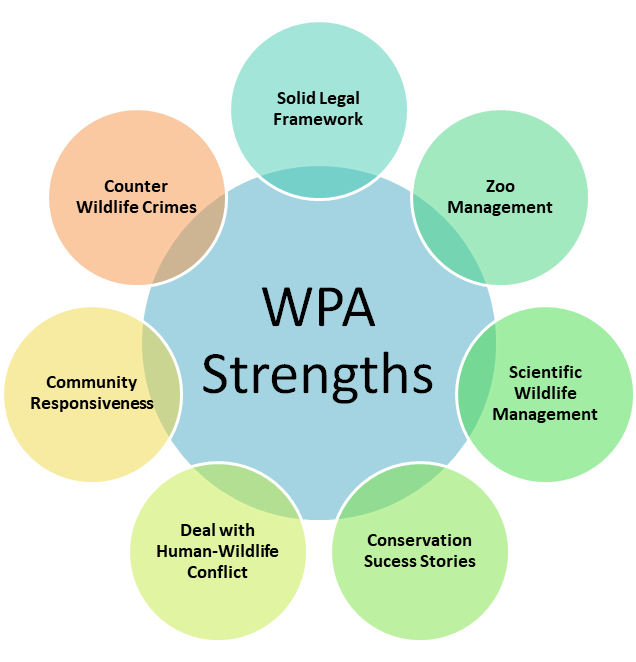
Perceived Weaknesses and Scope for Improvement
Albeit an umpteen Positives and Strengths of WPA exist, yet it can’t be called as the ‘silver bullet’ for Wildlife Protection. Some implementations, some procedural and some practical issues do shroud the flawless execution of this act. This point is further buttressed by the dynamic nature of Wildlife Crimes happening of late. In this section, I intend to highlight some of the weaknesses I perceive in the Present WPA Law along with a way forward in my humble opinion.
A. Implementation Lacunas
WPA, like any other legislation can only be as effective as its implementation.
While, by and large, the overall implementation is satisfactory, it can’t be denied that there are certain provisions in WPA that needs implementation in the right earnest.
For instance,
- Section 25A of WPA, sets the time limit for completion of acquisition proceedings as 2 years from the date of notification of declaration of Sanctuary under Sec. 18, however the same is sparingly observed on ground as the process gets mired into a ‘combustible’ mixture of human rights, political and vested interests and technicalities like paucity of documents or unavailability of suitable lands for the claim of the people affected.
Field Experience
Acquisition of land remains a daunting task. Post-1972, the Maldharis Settlement Areas of GIR (known as Ness) were sought to be shifted and their lands acquired. But even by 1998, not all could be shifted outside. Thereafter No Relocation of Ness was Possible for want of a Suitable Agricultural or Pastoral Land. Likewise settlement Villages defined under the Indian Forest Act, 1927 couldn’t be shifted completely till date.
Present Location of Maldhari Ness and Settlement Villages in GIR Protected Areas
- Section 28 of WPA, provides for allowing Tourism by the Chief Wildlife Warden in Sanctuary Area – while the Objective is to sensitize people towards forest and wildlife and render nature Education in short ECO-tourism. The Ground observation is mostly that people enter into sanctuaries for Recreational purpose while their sensitivity towards nature pollution and disturbing the wildlife leaves much to be desired!
Field Experience
Noise Pollution, Littering, unbridled and uncontrolled count of tourists and sometimes attempt to tease wildlife by mischievous elements can’t be denied even in Protected Areas. This disturbs the animals and negatively interferes with their hunting, feeding and even mating behaviour
Human Interference in Wildlife Habitats is on the rise (Source: Internet)
- Settlement of Rights not just in Protected Areas but also in Tiger Reserves under Sec 38 is to be read with the Provisions of The Scheduled Tribes and Other Traditional Dwellers or the Forest Rights Act, 2006: In spirit both Provisions are Sound for they uphold the rights of the tribals but practising it on Ground with Perfection is an uphill administrative task.
Field Experience
There are unmistakably chances of Double Whammy as those who truly deserve the benefit often don’t have requisite documents to fructify their claims. On the other hand, there have been episodes of Forging the Documents and benefits flowing to those who didn’t deserve it.
Also, post-FRA, there have been some repeated episodes of regularisation of Encroachments in Sanctuary and Forest Areas wherein mischievous elements have sought to concretise their dubious claims.
- Alteration in Lifestyle of Tribals and Other Traditional Forest Dwellers: Tribals are traditionally known for a symbiotic relationship with ‘mother’ nature. The same is still true at large but of late there are observations of drastic change in material aspirations and commensurately the lifestyle of tribals. This does augment the anthropogenic pressures on forest
Field Experience
- In Gir, Maldharis are undoubtedly revered for peaceful co-habitation with Lion but certain negative activities which came to my notice during my stint in GIR both during my Range Charge and as Assistant Conservator of Forest, were:
- Cutting and Lopping of trees for house construction and Fodder: Adversely affects vegetation
- Practice of mixing TOP SOIL AND Buffalo dung around ness : To sell as manure - deprives Forest soil of Nutrient Recycling
- Sometimes retaliation by the aggrieved Maldharis by poisoning the lion by lacing the carcass with insecticides
- Shifting of Ness by the Maldharis Annually with the approach of winters -on pretext of lack of Grass for their livestock. This "SHIFTING OF NESS" is analogous to "Shifting Cultivation". Results in Great Damage to the Ecosystem
- Land Records of the Revenue and the Forest Department seldom match exactly. This is exacerbated by the poor record-keeping or the preservation of records being unsound as well as by the fact that sometimes vested interests are at play in maintenance of records. Notably WPA under Sec 18(2) in declaration of Wildlife Sanctuary Area states “Notification shall specify as nearly as possible, the situation and limits of such area” and further elucidates that “it shall be sufficient to describe the area by roads, rivers, ridges or other intelligible boundaries”. Now, it is noteworthy that Rivers may dry up or change their course, roads and ridges may become defunct or could be widened or get dilapidated. Hence, if the boundaries of wildlife sanctuary are NOT DEMARCATED clearly by a Stable or fixed structure like boundary pillars, then it would be difficult to mark out the exact physical boundaries of Sanctuary. So, there can be a grave mismatch between what is on the documents and what is on the ground!
- Popular and thereby Political Pressures certainly keep human demands on higher pedestal – It is a common observation on Field that if a wildlife happens to have injured a human it is common to label it as a ‘Man-Eater’ even if it may be just a chance encounter
Way Forward
- Tourism must be within the carrying capacity of the Wildlife Sanctuary
- Unsustainable or Ecologically Unsound Practices of the tribals or other forest dwelling communities must be discouraged and checked
- Settlement of Rights as a technical exercise must remain so. It should be de-linked from vested rights – this may seem to be a utopian exercise but the effort must be to make the Process as OBJECTIVE as possible and based on facts. Also, there must be clear cut methodology to ascertain rights and time limits wherever given must be adhered to without any prejudices to the fact.
- Preparation of DIGITAL LAND RECORDS of the Forest land shall pave way to clarity – as being done in SWAMITVA Project for Land Record in Rural Areas
- Boundary Pillars must be installed invariably to demarcate the Wildlife Sanctuary. Also, routine vigil to check their damage or alteration must be observed. Indian Forest Act provides for penalty of up to 2 years on alteration of Boundary in forest.
- Community Dialogue is necessary to assuage their apprehensions of Wildlife being labelled out rightly as ‘man-eater’
B. Low Conviction Rate
Wildlife Sanctuaries and for that matter Forests in General are Areas of low communication and Connectivity. General Observation is that Forest Field Staff works hard on the ground. Yet the Conviction Success and even reporting of Offences is low.
Field Experiences
- Dearth of Staff: As a general observation of many government departments, high rates of vacancies exist even against the sanctioned strength and Forest department is a typical case of the same. Wherein, there are Forest Divisions were over 50% Staff Positions are Vacant against the Sanctioned Strength. In Gir Forests thus there are many cases when a Beat Guard (Beat is the smallest Administrative unit in Forest) may administer over 500ha of Forest – just a single person for such large patch!
- Very low bookings for offence against the Zoo Animals: Despite the fact that Sec38J of WPA explicitly states: “No person shall tease, molest, injure or feed any animal or cause disturbance to the animals by noise or otherwise, or litter the grounds in a zoo”, it falls short of Prescribing Penalties Explicitly in case of Breach of such Provision. Resultantly, incidents of penalising the wrongdoers against zoo animals are low on the anvil
- Lack of Resources: It couldn’t be argued otherwise that forest department in most states is awarded relatively low budget allocations. As a result, Infrastructure both with regard to Forestry activities and Patrolling Resources leave much to be desired. Also, it is also a common observation that the Personnel who don the forest Khaki often are not well equipped in terms of Protective Gears against the attack of Wildlife or Criminals. Most of the Offensive Gears/Weapons are either not present with the staff or if present, are found to be defunct.
- Lack of Training on Legal Aspects: Most of the In-Service Trainings or Refresher Courses for staff have little hands-on-training exposure! Trainings that Demonstrate and renders practical skills are needed on the ground. But, that is found to be missing in most cases. As a result, documentation and evidence generation and recording as well as other legal aspects leave much to be desired.
Way Forward
- Equipping the Staff with Protective as well as Offensive Gears is Sine qua non. At the same time, weapons training and routine maintenance of equipment is mandatory for the staff
- Staff Shortage must be addressed at Policy Level – this would give fillip to better employment prospects in the nation as well
- Trainings must not just be regular but also have a direct utility on field and practical orientation
- Strict implementation of punitive laws in event of teasing the wildlife must be carried out.
C. Possible Nebulous Interpretation
WPA despite all its Strengths does have certain definitions that could be wide or hazy depending on its interpretation. This could be gazed from the following:
- Sec 2(16) defines hunting with a very broad meaning – if Interpreted even an innocuous or chance encounter by a person with wildlife, could be fixed in definition of hunting.
Field Experience
In Gir Forest Region, incidents of Recording Videos of Lion and sharing them on Social Media have been observed multiple times – it becomes pivoted to the whims and fancies of the Investigation Officer on how he/she would treat this offence. Generally, an Innocuous or Unintentional share on social media with no intention to imperil the situation of Lions is treated with Warnings and a Written Apology. However, it does Warrant an SOP (Systematic Operating Procedure) on Field.
- Sec 2(2) defines animal articles but that definition excludes VERMIN –it is noteworthy that a Specie should be declared vermin only for a specified time period and there is thus a possibility that an animal article may be derived from a specie at the time when it was not declared to be Vermin – thus this may legalise the wildlife offence against that particular species.
Field Experience
In few states where certain species were declared as Vermin, people felt nearly a free license given to kill them. In garb of Protection against depredation of crop, indiscriminate killings have happened mostly out of vengeance.
- Issue of Jurisdiction- While any Wildlife Crime Committed over any area can be well taken cognizance of by forest department, more often than not, any successful nab of a deep nexus of Wildlife Offenders can only be possible through Inter-Departmental Co-ordination.
For Instance, any wildlife crime committed over Territorial Waters (Sea Routes as possible route to smuggle the wildlife articles is a commonly known fact) may require active collaboration with Indian Coast Guard, Marine Police or even Navy – Sec 2(30A) of WPA defines territorial waters in same terms.
Field Experience
Recently a case of Dolphin Hunt near Jamnagar came to notice of Forest Department only after active collaboration with the Indian Coast Guard – same might not have come to notice had the ICG not reported the same suo moto.
- Case of Community Reserve: Sec 36C (3) explicitly makes the land use pattern alteration a difficult task as it requires approval of State Government.
With changing lifestyle and material aspirations as well as alterations in means of livelihood, Demand for land Use Pattern Alteration is common but often what constitutes the land use pattern change gets hazy by words such as ‘Substantial’ change.
- Likewise, words like ‘Informed’ Consent of the Gram Sabha are hazy and pliable to interpretation that may suit parochial interests.
Way Forward
- Clear explanation of words that could be ambiguous or open to Interpretation like ‘Substantial’ or ‘Informed’ be done. Also, these should be object in terms of Quantity – example a Quorum of Members of Gram Sabha that would constitute a ‘Informed’ group could be laid down. Likewise, ‘Substantial’ land alteration could be quantified in terms percentage area or hectare or square Kilometre etc.
- Clear cut delineation of jurisdiction and responsibilities in even of an inter-departmental operation against the Wildlife Offence could prevent diffusion of the case because of compartmentalisation of responsibilities
- SOPs maybe laid down prescribing quantum of punishment for different categories of crimes. These should include social media cases as well
Hence, there is a Scope for Improvement for WPA Legislation to make it even better than present status and ensure it gets implemented in the earliest.
To sum up:
Blogs Home
